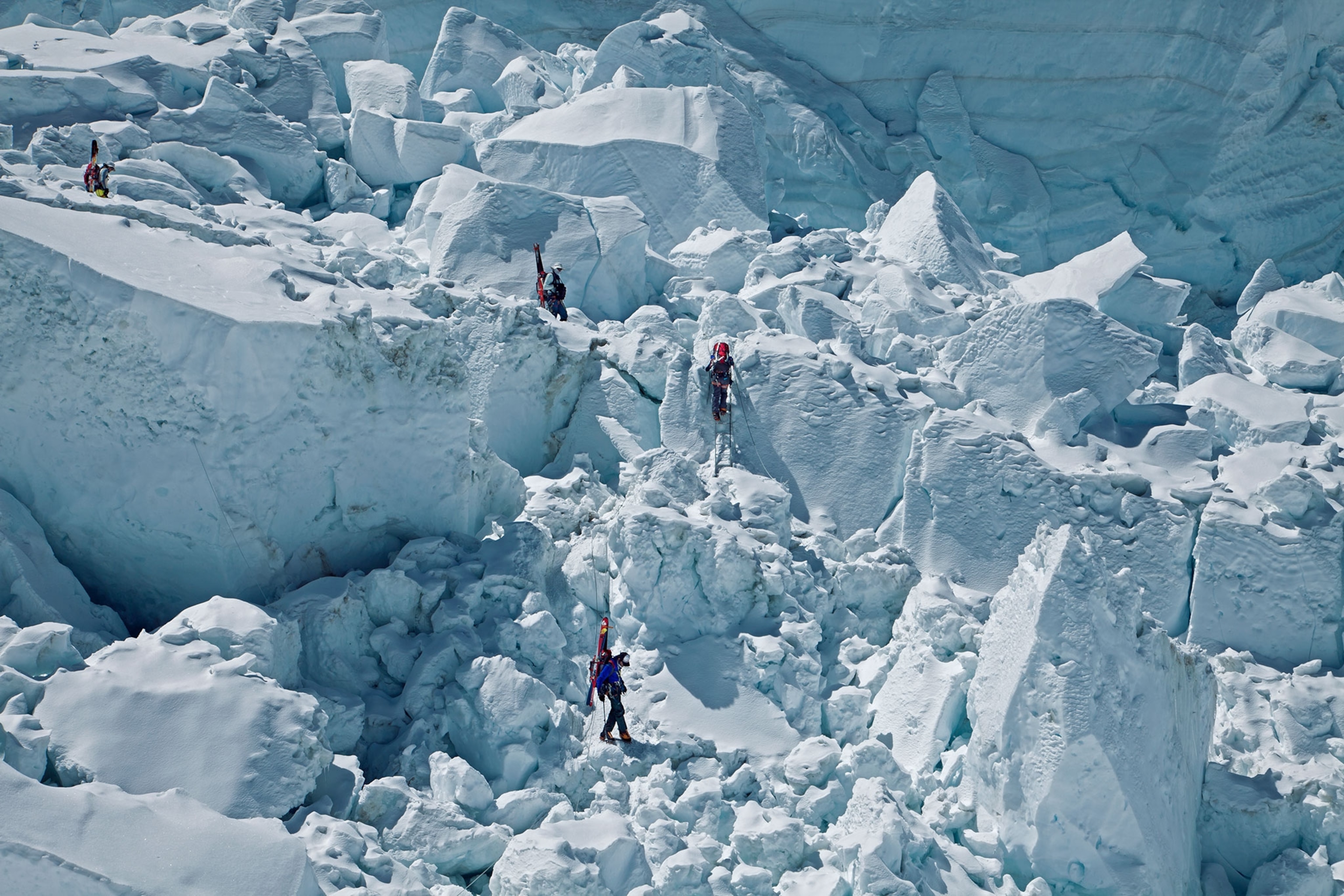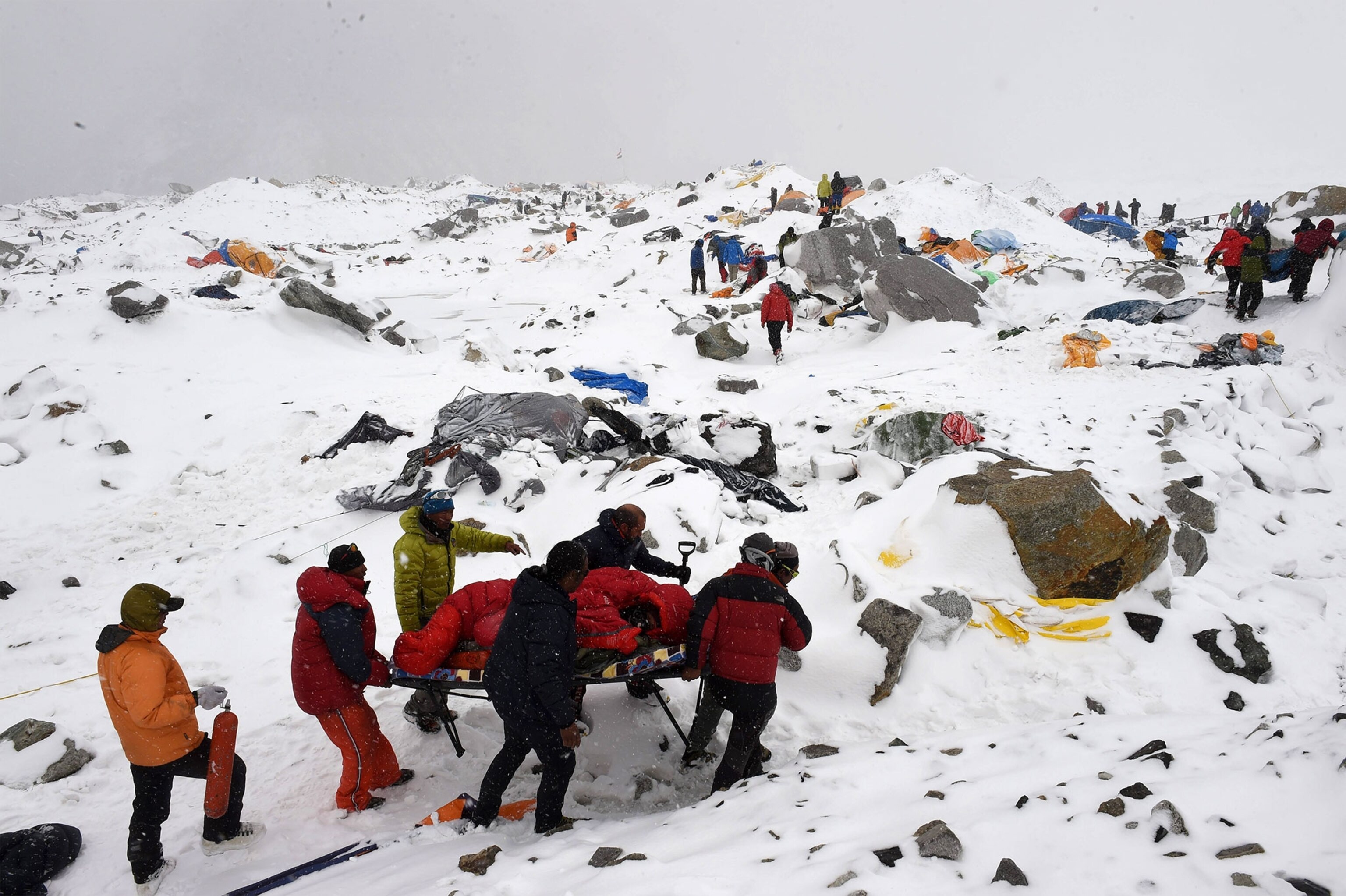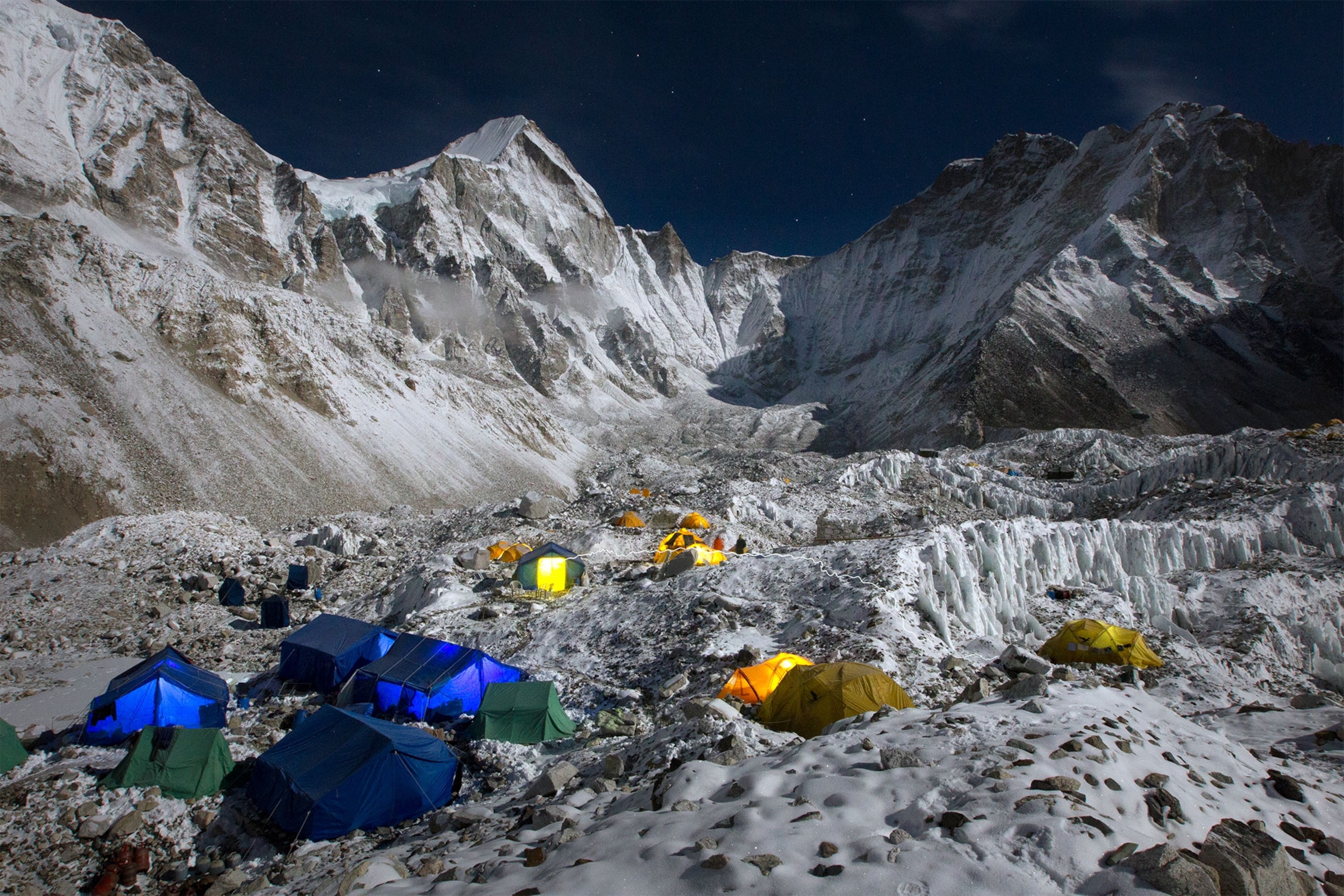
Nepalis Hold Their Breath as New Everest Climbing Season Begins
After two years of avalanches, earthquakes, and tragedy, climbers return to the world’s tallest mountain. But as usual, danger and controversy abound.
It’s that time of year when legions of mountaineers begin gathering on the flanks of Mount Everest, hoping to take advantage of a roughly two-month window of favorable weather to stake their claim on the world’s highest peak. Climbing season always brings a certain amount of drama to Everest, which will see teams making attempts from both the Nepal and Tibet sides of the mountain, but this year is particularly noteworthy, coming after three tumultuous and tragic seasons.
The 2013 season was marred by an ugly fight between Sherpas and three well-known Western mountaineers. The following year, 16 Nepalese mountain workers perished in an avalanche that swept through Khumbu Icefall, a treacherous expanse of moving ice blocks and crevasses that climbers must cross en route to the summit from the Nepal side of the mountain. Last year, a 7.8-magnitude earthquake shook Nepal, killing more than 8,500 nationwide and setting off landslides and avalanches that wiped out entire villages and roads. An avalanche of rock and ice hit Everest base camp, killing 22 climbers and support workers and trapping dozens on the mountain, which made 2015 the deadliest season in the mountain’s history. As a result, for the first time in 41 years, no one trekked to the top of the 29,035-foot mountain, and one of the most lucrative industries in cash-starved Nepal has remained all but dormant.
Meanwhile, the run of tragedy has stirred a number of questions among both Westerners and Nepalis about whether the mountain should be climbed at all. But as author and mountaineer David Roberts told National Geographic in the wake of last year’s tragedy, “There will be intense demand next year to open it up again.”
And so it has. Once again, with all eyes now focused on Everest, here is what to look for in 2016.

Earthquake Fallout
Nepal is still dealing with the aftereffects of the earthquake last year. More than 400 aftershocks—including a 4.5-magnitude tremor last Saturday—have rocked the country since the April 25, 2015 earthquake, which caused an estimated $10 billion of destruction. Though the villages in the Khumbu Valley, a popular trekking destination through which Everest-bound climbers must pass, have largely been rebuilt, large parts of the country still lie in ruins. In areas such as Dolakha and Okhaldhunga, residents survived a brutal winter and monsoon season living under tarps, with few signs of relief in sight.
Much is riding on a smooth 2016 Everest season, which in a normal year can be counted on to contribute $11 million to the anemic Nepalese economy and is often seen as a bellwether for mountaineering expeditions to the country’s lesser known peaks (which adds an additional $26.5 million) and for the country’s trekking industry (which accounts for $120 million).
Meanwhile, the number of Everest climbers is expected to be down. The Ministry of Culture, Tourism, and Civil Aviation recently stated that it has issued 275 Everest climbing permits this season (about 40 percent of these are extensions for permits issued during the ill-fated 2014 and 2015 seasons). By comparison, the ministry issued 315 permits in 2013, the last “normal” year on Everest.
Numbers from Jiban Ghimire, the owner of Shangri-La Nepal Trek, a respected local outfitter who also works with 12 Western guiding operations, are much starker. Last year, he had 43 clients on both the Nepal and Tibet sides of Everest. This year, he has 22 total climbers, and only three climbing from the south side, 32 fewer than in 2015.
Western guides are reporting similar decreases. Though some operations like Adventure Consultants and Madison Mountaineering claim their numbers are consistent with previous years', longtime Himalayan outfits such as Alpenglow Expeditions and Alpine Ascents International are seeing a 50 percent decline in their Everest business. Himalayan Experience, one of the biggest Western guiding services, has only seven climbers this season, compared to as many as two dozen in years past. Others, such as Rainier Mountaineering, have canceled trips altogether due to diminished client interest.
While Western guides are experiencing a downturn, low-cost local operators are more popular than ever. Whereas Everest expeditions with Western companies start at $65,000, local guiding services are offering no-frills trips for as little as $22,000. They’re appealing to a growing clientele of climbers from India, China, and the Middle East. This season will see 60 army personnel from India and the United Arab Emirates on Everest guided by these local, low-cost operators.
“I think it may be worst-case scenario for the mountain. If the cheap trips continue to grow, the level of experience, competence, and infrastructure will continue to drop. At the same time, more inexperienced clients are being accepted by those same cheaper companies,” says long-time Everest guide Adrian Ballinger, owner of Alpenglow Expeditions.
As a direct result of the diminished numbers and the rise of low-cost operations—which employ fewer staff—there is less work for Sherpas, the primary ethnic group who live in the villages splayed around the foothills of Everest. Guiding companies rely on small armies of Sherpas, renowned for their resilient lungs and strong backs, to haul gear and supplies for their high-paying clients up the mountain. Over the decades, many Sherpa communities have come to depend on Everest’s usually robust mountaineering economy. However, this year Ghimire hired only 21 Sherpas, compared to about 81 in 2014, and outfitters like Alpenglow are fielding desperate inquiries from Sherpas seeking work.
“There are many Sherpas who are not able to get jobs this spring. The earthquake made their lives much harder. Many spent most of the money they saved for their kids’ educations on rebuilding their homes,” said Lakpa Rita, the head Sherpa for Alpine Ascents.
Not only have Everest climbing businesses suffered but so too has the trekking industry in the Khumbu, the valley that stretches from Lukla to Everest base camp. Countrywide, trekking numbers in 2015 were down from 38,000 in 2014 to about 18,000, which means Nepal lost out on about $60 million in tourist revenue.

While villages in the Khumbu have largely been rebuilt and are ready to host tourists, the situation is drastically different in the neighboring districts of Okhaldhunga and Dolakha, two of the areas hit hardest by the earthquake, where many residents continue to live under tarps.
“For those that were most affected, there’s a zero percent chance the government will have built a single house by the time the one-year anniversary passes. Different political parties have been jockeying to put somebody in charge of $4.1 billion of relief aid so that they can skim as much of that as possible. (To them) that’s more important than providing relief to the community,” said Ben Ayers, the Nepal country director of the dZi Foundation, a nonprofit organization that helps remote villages in eastern Nepal.
Risking the Khumbu Icefall
Each year, an elite group of Sherpas called the Icefall Doctors build a route of fixed ropes and aluminum ladders—used by climbers like bridges to cross crevasses—through the Khumbu Icefall. After the 2014 avalanche that killed 16 mountain workers, they made changes to reduce the risks, shortening the route (which cut the time climbers and porters have to spend in the danger zone) and moving it to the icefall’s center, farther from the avalanche threat coming from the West Shoulder.
This year, the Icefall Doctors encountered far more large crevasses than in years past, with many new ones created by last year’s earthquake and others that had widened and deepened due to a dryer than normal winter. As a result, they have had to install more ladders than in years past.
To mitigate the icefall risk, several Western outfitters are lobbying the Nepal government for changes that would lessen the number of Sherpa trips through the icefall, which can be as many as 30 to 40 a season. (A regular paying client might make six to eight trips.) These proposals include leaving supplies at Camp II year after year; regulating what gear may be brought to Camp II; and flying loads by helicopter over the icefall, a plan that the government is currently discussing and may come into play this season.
“They are trying to sign the laws now. They are talking about 15, 16 flights altogether—carrying fixing rope, climbing tools—and flying that up to Camp II,” says Ghimire.
However, these proposals present an economic conundrum for Sherpas, whose wages could be reduced because they are paid, in part, per trip through the icefall, according to Jennifer Peedom, director of the 2015 documentary Sherpa.
Some Sherpas have decided to avoid the icefall altogether, requesting positions in base camp, pursuing jobs on the north side, or bowing out of the Everest game altogether.
“The Sherpa who have a choice not to work are recognizing the risk and stepping down, but there will always be more Sherpa willing to work because the money is just so good as compared to anything else they can do in the valley,” says Ballinger, who will climb from the Tibet side this year.
Rise of the Tibet Side
In reaction to events on Everest’s south side over the past few years, this season sees a noticeable shift toward expeditions climbing from Tibet, a route first made famous by George Mallory in 1924, when he disappeared on the northeast ridge while trying to make the peak’s inaugural ascent. Seventy-five years later, the peak again entered public consciousness when acclaimed mountaineer Conrad Anker discovered Mallory’s body at 27,000 feet, only adding to the north side’s intrigue.
For several years in the mid 2000s, the north side was the preferred route of many Western guiding operations. When the Chinese government abruptly closed the mountain in 2008, these outfits were forced to decamp back to the south side, losing hundreds of thousands of dollars in the process, and many have stayed in Nepal ever since.
However, the last few years have seen an increase in climbers heading to Tibet. Though it’s impossible to know exact figures because the China Tibet Mountaineering Association doesn’t release numbers, figures from Ghimire’s Shangri-La Nepal Trek illustrate the trend: He has 19 climbers on the north side this year, 11 more than in 2015.
After the 2014 avalanche, Ballinger, who has two climbers on the north side this year, moved Alpenglow’s Everest operation to Tibet because he believes the north side is significantly safer, particularly for mountain workers. It also offers a comparable summit success rate of about 50 percent.
“The north side has proven to be the much safer side when you go with a competent team or when you’re hired by a team,” he says.
That’s because a significant part of the routes on the north side follow a ridgeline, which means they’re less exposed to objective hazards than the south side, where the main route winds up a valley, subjecting climbers to avalanches and rock fall from neighboring peaks. There’s also less traffic jams thanks to fewer climbers and a series of ladders the Chinese government installed on the route for both ascending and descending climbers.

And then there’s the fact that climbing from Tibet avoids the Khumbu Icefall altogether, a feature that poses a level of risk that would be unacceptable to climbers in other circumstances.
“On any other mountain to go through an icefall like that would be really out of the question, and it’s only because it’s Everest that people allow that margin of objective hazard to exist,” says photographer Cory Richards, a former National Geographic Adventurer of the Year who will climb with Ballinger from Tibet this year.
But even with its relative safety benefits, the Tibet route carries risk in the form of the Chinese government’s unpredictability. This year, the Chinese announced they would open the border between Nepal and Tibet to climbing teams on April 10 but has since pushed the date back to April 15, forcing Tibet-bound expeditions to rethink their plans. Ballinger and Richards have spent the last week acclimatizing in and around the Khumbu Valley and are now set to leave for Tibet on April 20.
Beyond the political instability, critics of the north side also claim that it’s colder, windier, longer, and more technical. Camp IV, the final rest stop before attempting the summit, is at 27,000 feet, almost a thousand feet higher than the south side’s last camp, which means climbers spend more time in the Death Zone, the area above 26,000 feet where lack of oxygen begins causing the body to shut down.
There’s also less infrastructure in case something goes wrong. “On the south side you’ve got communications, helicopters to get people in and out, and a permanent medical clinic, which is not on the north side, so those things also factor into the larger idea of risk management,” says Gordon Janow, director of programs for Alpine Ascents, a popular Western operator on the Nepali side.
Notable 2016 Ascents
Politics aside, a few of this year’s expeditions, if completed, will stand out.
Ballinger and Richards will climb from Tibet without the use of supplemental oxygen, a feat that’s significantly more difficult and more dangerous than climbing without it. (You can follow their progress on National Geographic Adventure.) Only about five percent of Western climbers have reached Everest’s summit without “O’s”, as supplemental oxygen is called among mountaineers. The death rate for those climbing without oxygen above 26,000 feet is at least five times higher, according to Peter Hackett, director of the Institute for Altitude Medicine.
That’s because at that altitude, the lungs simply can’t get enough oxygen to the body, causing a profound loss of brain and body function. “Climbing without oxygen to the summit of Everest is allowing your body to slowly die,” says Hackett.
While Richards climbed Pakistan’s 26,362-foot Gasherbrum II without supplemental oxygen in 2011, it’s a first for Ballinger, who has topped out on Everest six times previously.
“I always knew that climbing Everest without oxygen was a much greater challenge and purer way to approach the mountain, and I’ve always wondered if I could do it without supplemental oxygen,” says Ballinger. “With it being a much quieter year on the mountain this year, it felt like the right time to try.”
To prepare for the climb, Ballinger has been clocking in 20,000 to 50,000 vertical feet of climbing a week—mainly on skis—and sleeping in a hypoxic tent, which simulates the thin air at altitude and helps acclimate climbers up to 18,000 feet.
Richards has been working with alpinist Steve House on his own customized training program. A typical training day sees Richards walking on a treadmill set at a 15 percent gradient for five hours while wearing a heavy pack.

Meanwhile, on the south side, 84-year-old Min Bahadur Sherchan will defy a new Nepali ban on issuing permits to climbers older than 75 and will try to become the oldest person to stand atop the world’s highest peak. He first accomplished the feat in 2008 at age 76, breaking the record previously held by Japanese climber Yuichiro Miura. Since then, a rivalry has erupted between the two mountaineers, and in 2013, Miura returned to Everest and reclaimed the record when he summited at the age of 80. Sherchan hoped to regain the record last year but was thwarted by the earthquake.
Also, Slovak alpinists Vladimír Štrba and Zoltán Pál will attempt the rarely trod and dangerous British Route on the southwest face, which was first climbed by British mountaineers Chris Bonington, Dougal Haston, and Doug Scott in 1975. Climbing with minimal gear, the duo will ascend without Sherpa support or using fixed ropes. “Our goal is to climb as a sole pair of mountaineers relying on our experience, skills, and fitness–the purest possible way,” the pair announced on their website.
And while it remains to be seen what will unfold this season on Everest, many see it as a time of transition. “It’s a year of recalibration,” says Guy Cotter, CEO of longtime Himalayan outfit Adventure Consultants. “Now we’ll just wait to see what happens.”
Kelley McMillan is a freelance journalist based in Boston.






